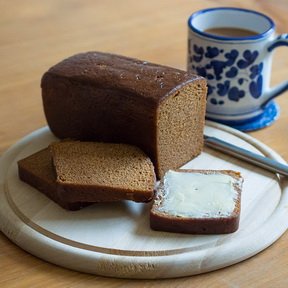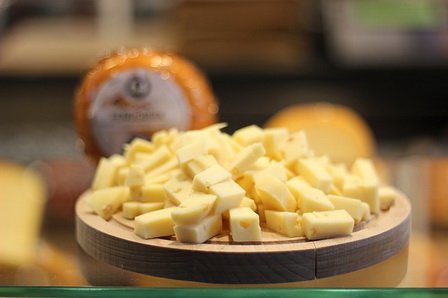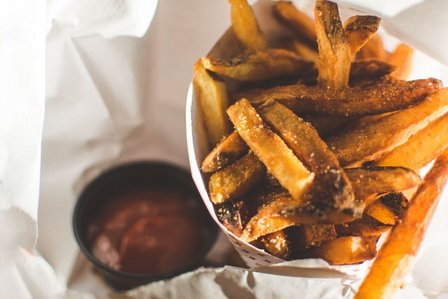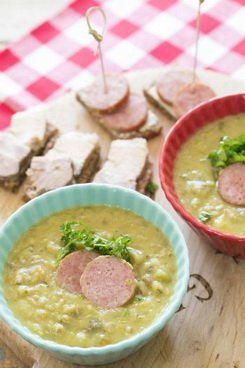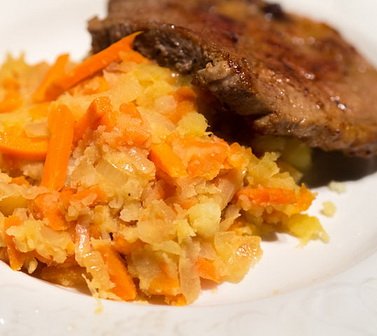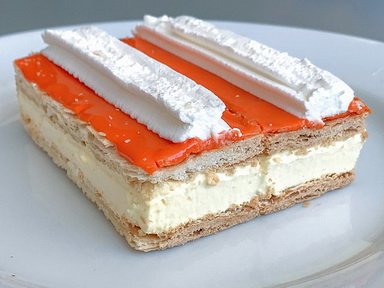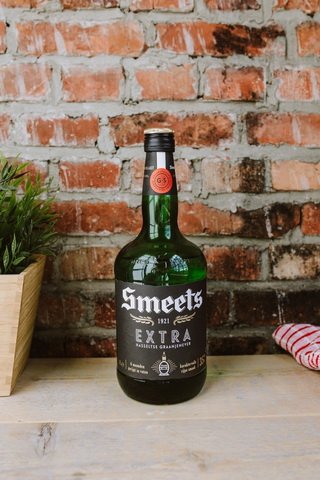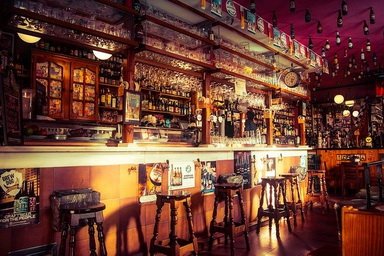To eat or not to eat… good question
What food should you try in Amsterdam
To eat or not to eat… what’s the answer?
What for breakfast? Ojtbijkoek – Bites – cheese… – Herring – Bitterballen – Dutch fries – Licorice – Mains – soups – Panenkoek – Kibbeling – Stampot/Hutspot – Rijstafel – Sweets: stroopwafel – Olienbollen – Poffertjes – Other sweets – Drinks: Jenever – Beer
T
asting food of another country is like diving into its inner mind. In Amsterdam, it will show you the story of a city with a colonial past. Some dishes from Indonesia, Suriname, or the Antilles have been adapted and transformed. They are part of the local culture now and nobody imagines Amsterdam without them.
The flavors will tell you about the fishing industry, Hanseatic League port, cold nights, and the ways to keep you warm. The dishes will be as colorful as the people, they will satisfy every hunger and bring you sweetness and energy. They may tell of simplicity, but they are pure and honest in their everyday character.
But most of all – the atmosphere of the brown cafes, the tables sitting next to the canals and the breeze of the sea will make the experience unforgettable.
What for breakfast?
Amsterdam people are not big fans of breakfasts. They prefer to eat twice instead. For them breakfast is between 6-8 AM… it seems understandable that some lunch or the “second breakfast” could be eaten quite soon.
Since there is usually little time and even less hunger in the morning, the first meal is small. Dutch people like a simple toast with toppings – salty or sweet. A piece of bread with the delicious local cheese is mouth-watering. But they can surprise you as well – putting chocolate sprinkles (hagelslag – comes with a variety of tastes) on top is also normal… and crunchy!
Try the ontbijtkoek – a gingerbread loaf made with rye flour. It is sweet, satisfying on its own or with something on top of it.
Oatmeal with different ingredients is coming back because of the healthy lifestyle times. But what if you are hungry a bit more… Or it is time for the second breakfast already?
Tosti is always a good choice. A simple sandwich is fried, grilled, or roasted. There can be anything inside – from the standard cheese to delicious fresh beef and salad. They became quite popular in the times of the countermovement to superfoods. And Amsterdam offers us many different variations.
“English breakfasts” are less popular among locals, but they are forever there for tourists. We cannot find anything wrong with eggs, salad, and toast… Try also the eggs benedict – there is the Hollande sauce inside after all.
Bites
Since a tourist wants to try as many things as possible, you can decide to have something else for lunch. After all, these are your holidays, you can eat whatever you want. Even smoked mackerel – which is actually quite popular as a breakfast food in e.g. Poland.
Cheese
Oh! That is a long story…
Maybe even the country should be called Cheeslland… The first mention of the Netherlands production of cheese was made by Julius Caesar. That is quite impressive, but we will not dive into the subject of ownership, since it will cause a cheese war between Netherlands, France, and Italy.
You have probably tasted the Dutch cheese before. Some of the most famous names are Gouda and Edam. They were given the name because the cheese-trade was first recorded in those cities. Holland people love this product! Life of their country concentrates on cheese and flower festivals or some other events connected to both.
The tradition was to eat plain bread and cheese – they were complementing themselves into a savory experience since the beginning of time. And so, it is until today and in large quantities. This is one of the most common things eaten for breakfast or lunch. Holland produces 800 million kilos of cheese a year! It is heavily exported; tourists tend to buy a lot… and the Dutch people eat their share (17 kg/person/year).
In Amsterdam you will find some great tasting shops, a museum of cheese and day-tours possibilities to go out of a city to the cheese factory. Try other, less known types: Leerdamer, Old Amsterdam, Maasdamer, or a variety of goat’s cheese.
Herring and smoked fish
It may sound strange, but a simple herring (a type of small fish, bigger than sardine) can be street food. People all around the Baltic and the North Sea love it. It can be a simple snack or a part of a hearty dish.
In the Netherlands, a piece of herring was traditionally grabbed by a tail and eaten with fingers. You held the whole thing above your mouth, tilted the head, and took a few bites. For some outsiders, it brought the idea that the fish is eaten raw, which was and is not true (think of it as salty sushi).
The practice of putting the fish into the saltwater to conserve it is ancient. The herring is gutted on the boat, salted, frozen (preserves and gives tenderness), and transported to the port. This means it is already a bit salty. With the time passing and salt traversing the fish, you get a delicious product. There are many ways to go from there – each one depending on the country you are visiting.
Amsterdam has fishmonger stalls where you can buy a slice of herring, already pre-cut, with the addition of onion, pickles, and a toothpick to use as a fork. Try finding a place where you would see how everything is prepared – it is some guarantee of freshness.
see this movie for some insiders’ knowledge
This experience costs less than 5 euros, but the Hollandse Nieuve can be more expensive. This is a special kind of herring, caught in spring and accessible in shops from the beginning of June until the end of September. There is a whole custom about it and the details say it must have exactly 16% of fat. What is more if the fishmonger lies or sells it out of the season, he can be fined with over 10 000 euros!
If you are not that fancy of salted fish, try the smoked delicacies – smoked mackerel is to die for. Smoking is just another way of preserving food, beloved in some regions of Europe. It gives this special woody-sweet taste and can change the way you see a dish/snack completely.
Bitterballen
Recipe link
Small, deep-fried balls full of savory filling are the perfect snack typically accompanying the Dutch beer (maybe the bitter taste of beer gave the name to the food). They usually arrive with some mustard or fries – it depends on what you want.
The soft insides are made of different kinds of meat, stock, flour, and vegetables. The ready dough is put into the fridge to harden. Then – small balls are formed, covered with breadcrumbs, and fried. It is both difficult and easy to make them. The trick is in the dough, which cannot be too hard – therefore it is put into the freezer.
The effect is the perfect crunchiness followed by softness hidden inside. The size is just right as well – a bite – not too much, not too big. There is something for beef lovers and there are even veggie bitterballen, although the original ones were filled with meat.
If they are formed into an oblong shape the name changes. Now you have a few bites instead of one, and the delicacy is called croquet. The most amazing thing in Amsterdam is vending machines with those! (Try the FEBO fast food stores).
In our professional opinion, there is no point looking for the perfect bitterballen – they are equally delicious in so many places.
Dutch fries
Yes – fries are something that you need to try in Amsterdam. It is not an exaggeration to say that after this experience you will compare all the fries to the ones from the Netherlands.
Firstly, they are made purely from cut potatoes. Nothing else! You get a vendor with a cart full of those, he is chopping them on-site and putting them into the frying machine. Plain and simple but makes so much of a difference. Probably the local vegetable is just of the right quality – but the freshness of the product also makes the difference.
Fries come to you in a cone, sometimes shaped specifically to include a cup for the mayo. No need to worry about dropping everything down. And perfect for those who like to dip. Toppings are also popular, and they can astound you – just imagine mayo and onion together. The taste is delightful.
Dutch licorice
A word should be said about this sweet which can be not-sweet in Amsterdam. The locals love to bite on the savory, gummy texture of the tiny black, bites. But there is a trap in there… if you are a tourist.
Not many people know that the local licorice is made salty creating a novel experience for some unknowing tastebuds. You see the people eating the small chunks – you want to try it as well and then… a surprise!
Be wary of this and give it a try knowing it – possibly buying a little to make everyone taste it. You may love it or hate it. The locals call it drop. They are typically black, in simple shapes, and salted. But there are many other varieties, and you will see a multitude of shops selling them.
Beware – those not liking the anise taste should avoid it.
Main dishes
Before Amsterdam became important life there was cold and hard. The food was sustenance and was supposed to serve this very purpose. Dinner was eaten early – to give energy for the evening work. There was a lot of thick soups and meat with vegetables. It is still so until today.
Normally the Dutch try to eat before 6 pm, although it changes with the changing world. Traditional soups can become a meal on their own – eating two dishes seems too much now. And the mains have smoked sausages or spiced meats, which are simple, healthy, and delicious.
Soups
There are many traditional soups in Amsterdam but Snert may be the most known, partly because of a competition held to its name. It is an incredibly thick split pea, vegetable, and pork cream topped with a few chunks of sausage and accompanied by a slice of bread. It is a winter soup and is traditionally eaten in the New Year.
The bean soups are another local favorite – humkessoup being one of them. The idea was simple – make it as nutritious as possible and serve it hot. This is what helps you survive the winter.
If you enjoy these kinds of food, you will eat well and cheap in Amsterdam. They are recommended for everyone – even as a curiosity.
Pannenkoek
It may seem strange not to roll or fold a pancake, but this is what they do in Amsterdam! Round and flat, like straight from a frying pan.
They are less of the American pancakes but more of French crepes, not really being that thin. This makes them suitable to satisfy a mild hunger.
They can arrive with a variety of salty or sweet toppings – perfect for all lovers of pancakes.
The Dutch variation comes from Nepal or China and was introduced in the XII century. This basically means that there is a lot of buckwheat inside. The batter is also quite thick making it similar to the Polish recipe. Don’t think of it as rocket science – just have a taste of this “every day and everywhere food”. They say that Pancakes Amsterdam (near Oude Kerk) has quite a broad selection – maybe you should check them out (if not see the Pancake Bakery close to Anne Franck Museum).
Kibbeling
This is both a dish and a bite. It only depends on the things you want to eat with it.
Kibbeling is typically white fish, covered in breadcrumb and deep-fried. They normally use a cod, but it may differ.
When eaten as a bite it is served with some sauce e.g., garlic sauce, where you can dip the small chunks and give them some additional flavor. The full dish is served with fries, salad, and sauce and is tasty and satisfying.
Stamppot or Hutspot
It is basically a dish consisting of meat with mashed potatoes and some additional vegetables. Some of them can be mashed as well. Its simplicity is matched by XXI century varieties and love for this wonderful dish.
There are two main variations – if the potatoes are mashed with carrots and accompanied by Klapstuk – braised beef – the dish is called Hutspot. If some other vegetables are mashed with potatoes, e.g., kale, and it is served with the Dutch rookworst sausages – the dish is called Stamppot.
No one knows how it started, but they say that around the 1600s the popularity of stamppot was mind-bending. It was so easy to get full fast and cheap that it became the most beloved dish.
There is a cute legend about it, coming from the times when the Netherlands’ people fought in the 80-year Spanish war. The Spaniards were finally removed from the besieged city of Leiden. They left in a hurry leaving behind a mixture of mashed vegetables and meat. The hungry citizens devoured the food, liked it, and not knowing how to call it gave it the name of the hutspot. It basically means mixed pot which is a perfect description of this dish.
Colonial influence – Indonesian and Suriname cuisine
Rijsttafel would be your main choice if you came to Amsterdam with a group of friends. The translation means a rice table. It is a variety of dishes from Spice Island which were redeveloped by the Dutch over the years. If you order it, you will get a few (once it was about 40!) small savory plates which you can pair with rice achieving a perfect balance of sweet, sour, and spicy. Try also the satay chicken in the smooth peanut sauce or some Surinamese roti – yet another kind of fast food.
Although this is the main area of colonial influence, you should also be warned that there is a strong Chinese/Taiwanese presence in the region. Amsterdam is said to have its own Chinatown, with the Chinese names of the streets and a Buddhist temple. You are bound to find some delicious Asiatic food in there too.
Stroopwafel
It is the king of all the sweets in Amsterdam. If there existed a national sweet – this would probably be it. It is even given in the Dutch airlines to the passengers.
You must try it. It will arrive on top of a coffee pot, getting warmer and softer as it breathes the warm coffee vapors. Or it can be sold directly from a vendor – freshly grilled and with a spread of chocolate between the crunchy sheets of the stroopwafel pancake. Find your own favorite – with sprinkles, with caramel or plain – with a cup of hot chocolate to dip it in.
For those who have no idea what it is – imagine a sweet wafer sandwich that has caramel or chocolate spread in between. The recipe for the dough is very similar to the waffles, even the name gives us some indication. The layers are thin and create a crunchy treat that seems to be the most delicious when eaten still warm.
Olienbollen
This is the well-known comfort food know as doughnuts. They are a little bit deformed here but come in the size that is just right. The deep-frying makes the skin crunchy while leaving the interior soft and tasty.
They are served covered in a mist of sugar. Plain or the dough is mixed with raisins for additional flavor.
The local tradition says that it was first served during the German Yule (Christmas festivities). It was commonly served during the same period. Although you can get it any time of the year, its popularity is astounding during the winter months.
Try it like the locals – with a cup of fresh coffee.
Poffertjes
They are another well-known type of food but turned into art in the Netherlands. You surely remember the fluffy American pancakes. But imagine them being small just for a bite.
This created the whole other culture of the tiny, fluffy discs, baked at the stalls next to the street. A machine with a few dozens of holes is covered in yellow circles of the dough. It is grilled fast and efficiently and the vendor turns it like a pro. If you pay a few euros you will get the poffertjes covered in powdered sugar, sprinkles, and a toothpick to serve yourself.
The rumors say that they started in an abbey. They were served as a communion. Nobody knows now. But have a try in Amsterdam or in any X-mas market around the world. They have become a very popular, street snack.
In any country, you will find a variety of local sweets on the streets of Amsterdam. The apple pie is the uncrowned king – served warm with or without cream. The apples are in chunks and it is both a cake and a fruit. Tompouce is a cream cake, invented by a local chef and named after a famous admiral, who was a dwarf. There are two layers of puff pastry with cream in between them. The top is covered with icing of various colors. Some shops get a cute, Netherlands flag on top since it is found to be a local invention. When the top layer turns orange, you may be certain that you approach the Konigstag – the national celebration day of the end of April. Bossche bol is also quite popular. It is a kind of profiteroles – a puff with cream filling and chocolate icing. Depending on the place you can get different sweets with your coffee or mint tea. The tea is actually an infusion of mint leaves and hot water – but they love it here this way.
Jenever
The story puts jenever in the abbeys, where it was used as a medicinal remedy. It was never called “the water of life” in the Netherlands – and many similar alcohols are called like that in Europe. But not far after this moment, an alchemist named Franciscus Sylvius de Bouve is said to invent the first jenever. Maybe he was using some old’s monk recipe?
It was in the times of the lessening of the taxes on alcohol, which makes the tale less mysterious. Jenever became what gin was in Great Britain – it is even called its predecessor. Both alcohols are made using juniper berries, so let’s not look into the differences too closely. As a matter of fact, jenever has a more, malty flavor that puts it next to the whiskeys. The distillation process also varies.
You have no other choice than to make your own opinion. Try the liqueur in one of the local tasting parlors. Traditionally the glass jenever should always be filled right to the top. It is so, to make you drink the first sip without using your hands. It is served cold or, the more mature versions, in-room temperature. And the devil created a jenever-beer mixture, which will be explained below.
The Dutch beer
Beer is as old as the civilization. It was drunk by everyone, even children, for a while – water was too contaminated and milked spoiled quickly.
For a moment there were over 700 breweries in the Netherlands (the XVII century). Every city had its own. Although today you may know many famous brands of Dutch beer (Heineken, Amstel, Grolsch, Bavaria, Brand, and Hertog Jan), try the craft beers from the local distilleries. It is a journey on its own.
You can try the Heineken experience or go to a brewery for a tour. There is even a beer festival in the city – or rather a few different occasions to celebrate the golden nectar.
If you want something cozier – just go to the bar you like the most and order something fresh with a bowl of bitterballen to satisfy the lingering hunger. And if you are feeling adventurous – try the submarine. You will either go to the depths of the consciousness with it or visit Mars… it is a glass of beer with a shot of jenever sunk at the bottom. When you drink you slowly mix the two alcohols and receive a gift of a third one – which is absolutely amazing and dangerous.
You don’t believe us? Try it of your own volition.

